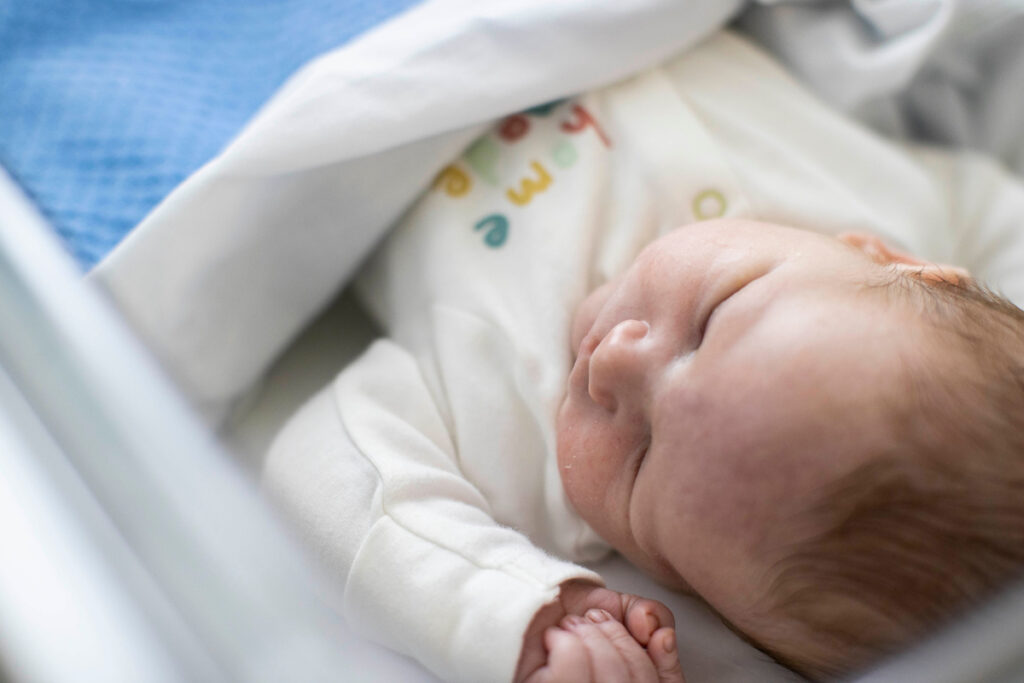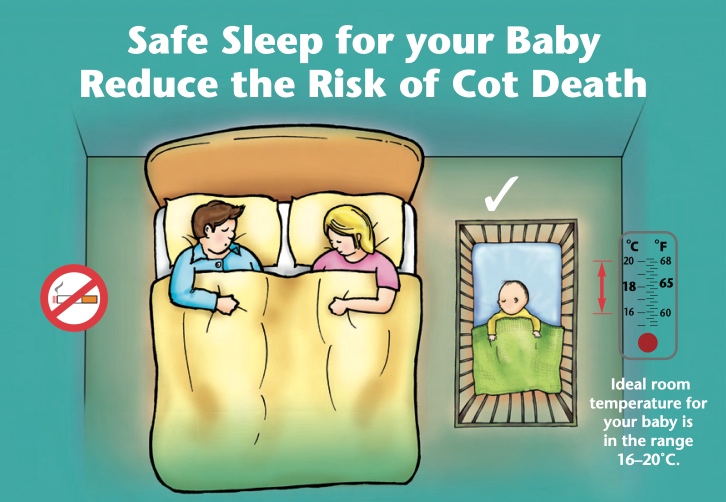Going Home - At Home
Sleep
Sleep is very important
- Sleep is important for baby’s growth and their development.
- Sleep helps your baby to be less irritable and fussy, and helps them to be more calm.
- It can take some babies quite a while to get into a sleep routine, and that can be hard for parents to manage.
The sleep of preterm babies is easily interrupted and they may need help to settle back after a disturbance.

Safe sleeping position
Safe sleep
It is also important to follow safe sleep guidelines for your baby.
Safe sleep guidelines are important to help reduce the risk of sudden infant death syndrome (SIDS) (cot death).
SIDS does not happen only in a cot – it can happen anywhere a baby is sleeping.
Reproduced with kind permission from the National Paediatric Mortality Register (NPMR) and HSE Child Safety Programme, 2018.
Baby’s cot and blankets
- Babies should only sleep on their back.
- You should never use pillows or sleep positioners.
- Position your baby’s cot away from radiators, windows and outer doors to protect them from over-heating and cold drafts.
- Use a clean firm mattress that fits the cot correctly.
- Make up the cot with enough thin layers of bedding to keep your baby warm.
- If you need an extra top on while indoors, your baby might need an extra blanket. If a blanket is folded, consider it two layers.
- Use aerated/cellular blankets and cotton sheets that allow air to pass through.
- Before you go home, check with your baby’s nurse as to how many layers you can safely use for your baby, both in their cot and out of it. Generally smaller babies need to be kept a little warmer than bigger babies are.
- Tuck covers in loosely but securely and keep them below your baby’s shoulder level to make sure they cannot slip over their head.
- To check how warm your baby is, feel their tummy. It should feel warm but not too hot. If their tummy feels hot (or if they are sweating anywhere), remove one layer and test again. If your baby’s tummy feels cold, add a layer. Do not worry if your baby’s hands or feet feel cool, this is normal.
- Gro-bags for sleeping may be used instead of blankets provided they fit correctly. Check that the thermal value/TOG is appropriate.
- Do not use duvets, quilts, pillows and bumper pads with your baby until they are at least 1 year of age.
- Do not leave toys, teddies and other items in the cot with your baby.
Safe sleeping positions
- Pillows are not safe for babies and should not be used.
- Always position your baby to sleep on their back, face up and face free from blankets.
- Always place your baby’s feet to the foot of the cot, moses basket or pram, so that they cannot wriggle down under the covers and risk covering their face.
- Vary your baby’s head position when sleeping, i.e. swap their head between facing to the left or to the right side to help them to avoid developing a preference for one side.
- Never fall asleep with your baby, this includes in a bed, on a sofa, armchair or beanbag.
- The safest place for your baby to sleep at night is in a cot or moses basket in your room.
Did You Know?
The risk of sudden infant death syndrome (SIDS) is much higher if you or your partner smoke, take drugs or medication that make you sleep more heavily.
For further information on safe sleep for your baby, please check with the HSE, see www.mychild.ie



